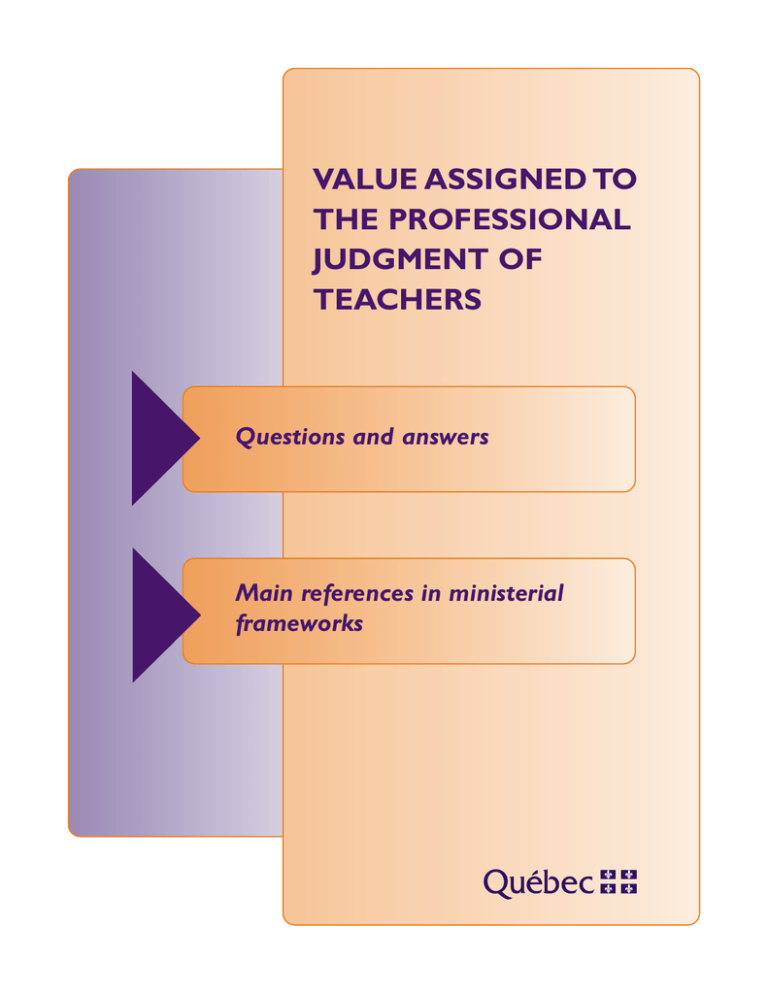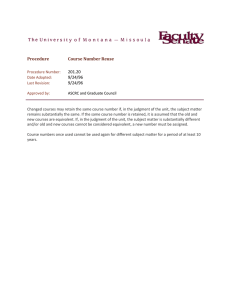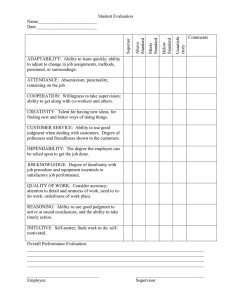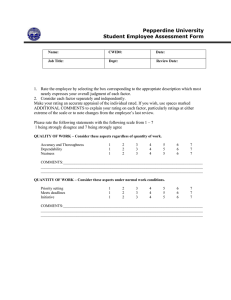value assigned to the professional judgment of teachers
advertisement

VALUE ASSIGNED TO THE PROFESSIONAL JUDGMENT OF TEACHERS Questions and answers Main references in ministerial frameworks VALUE ASSIGNED TO THE PROFESSIONAL JUDGMENT OF TEACHERS Question 1) What is judgment? Answers – Judgment consists of analyzing and summarizing information that has been collected about student learning. It leads to situating learning in relation to the requirements established at different stages in the learning process. Making a judgment is not the result of compiling data. It cannot be reduced to adding up the different marks a student has obtained throughout the cycle or school year. – According to the Policy on the Evaluation of Learning, judgment is a factor throughout the evaluation process. It serves in planning for evaluation, choosing evaluation methods and tools, and making decisions about student learning. – In addition, judgment is a stage in the evaluation process, and is present in the following three contexts: - Judgment in the context of a complex task - Judgment on the status of the development of the competencies to be noted in a report card - Judgment on the level of development achieved for each of the competencies to be noted in a competency report – Having teachers make judgments is not a new concept. Teachers have always interpreted information collected on student learning.A new aspect, however, is the emphasis on teachers’ professional judgment throughout the evaluation process. 3 VALUE ASSIGNED TO THE PROFESSIONAL JUDGMENT OF TEACHERS Question 2) What conditions are required to ensure quality judgments? Answers – For judgments to be of quality, evaluation must be rigorous and transparent or open. First, this means that the values of the evaluation of learning must be respected. It also means that the evaluation process must be followed. The teacher must establish the intent of the evaluation, identify the aspects of learning he or she wishes to observe, and select and use the appropriate evaluation methods and tools for the context. – The aspect of openness in evaluation means that the teacher informs students of what is expected of them, and of the criteria and requirements that will be applied. It also means the teacher must be able to justify, to students and their parents, his or her judgments and decisions about student learning. – For judgments on student learning to be of quality, teachers use a variety of evaluation tools to help them assess competency development. – For judgments to be of quality, the school team may use several methods, which it will include in its school’s evaluation standards and procedures. For example: - Planning for learning and evaluation allows the teacher to plan to gather data that is relevant, sufficient and valid in order to make judgments on student learning during and at the end of the cycle. - By basing the observable elements on the evaluation criteria set out in the QEP, teachers gain a consistent understanding of the criteria. - By matching student exemplars with different competency levels, teachers gain a consistent understanding of the levels. – It is important that each school community allow itself the time to adapt to using new methods and to building the skills required for making judgments. 4 VALUE ASSIGNED TO THE PROFESSIONAL JUDGMENT OF TEACHERS Questions 3) Can a teacher’s judgment be called into question? Answers – Parents, students and school administrators may call a teacher’s judgment into question. They may ask the teacher to justify or even change it. – The teacher must be prepared to provide the justifications requested. He or she must keep a sufficient amount of relevant information gathered from evaluations and be able to explain how he or she analyzed and interpreted the information and made a judgment. – Teachers must take every precaution to minimize subjectivity when making a judgment. 4) How many learning and evaluation situations are required for a teacher to make a judgment about student learning? – The number of situations depends on the goal of the evaluation, the nature of the competency and the learning conditions, particularly the number of times the teacher sees the student in a given period of time. – However, for a judgment to be credible, the student must have had sufficient opportunity to demonstrate what he or she has learned. In all cases, the teacher must gather enough records of student work to make an informed judgment during or at the end of the cycle or school year. – Although a sufficient number of situations is required to allow the teacher to make an informed judgment, it is also important to ensure that the observations made are relevant to the competencies being evaluated. The selected situations must be suitable for evaluation of the competency in question. – Finally, the teacher must ensure that the samples of student work that have been collected reflect student learning at the time the judgment is made. Indeed, the most appropriate observations for the competency report are usually those collected near the end of the cycle. 5 VALUE ASSIGNED TO THE PROFESSIONAL JUDGMENT OF TEACHERS Questions 5) What should be the basis for the teacher’s judgment? Answers – The teacher should base his or her judgment on the information gathered using either formal or informal instruments. Observations of student learning may be recorded in different ways: evaluation grids, the teacher or student logbook, student work, examinations, or the record of learning and evaluation such as a portfolio. – In order to interpret the information gathered during complex tasks, the teacher uses evaluation grids based on the evaluation criteria set out in the QEP. – In elementary education, the teacher may also use the competency levels to support his or her judgment of student learning. In secondary education, the teacher must use the scales of competency levels when preparing the competency report. 6) Must teachers work together to exercise their professional judgment? – Under the Act, there is no requirement to this effect. The Act recognizes the teacher’s right to examine and assess student learning. – However, a teacher may collaborate with or consult colleagues or other professionals when evaluating, thereby strengthening the credibility of his or her judgments on student learning. 6 VALUE ASSIGNED TO THE PROFESSIONAL JUDGMENT OF TEACHERS Main references in ministerial frameworks Prescriptive Education Act (hereafter, the Act)1 • Section 9: A student or parents of a student affected by a decision of the council of commissioners, the executive committee or the governing board [our bold type], or of an officer or employee of the school board may request the council of commissioners to reconsider such decision. • Section 19: In accordance with the educational project of the school and subject to the provisions of this Act, the teacher has the right to govern the conduct of each group of students entrusted to his care. The teacher is entitled, in particular, 1) to select methods of instruction corresponding to the requirements and objectives fixed for each group or for each student entrusted to his care; 2) to select the means of evaluating the progress of students so as to examine and assess continually and periodically the needs and achievement of objectives of every student entrusted to his care. • Section 22: A teacher shall 1) contribute to the intellectual and overall personal development of each student entrusted to his care; ... 7) comply with the educational project of the school. • Section 96.15:The principal is responsible for approving, on the proposal of the teachers[:] ... 4) the standards and procedures for the evaluation of student achievement in keeping with the prescriptions of the basic school regulation and subject to the examinations that may be imposed by the Minister or the school board; ... The proposals of the teachers or the staff members under this section shall be made according to the procedure determined by the teachers or the staff members at general meetings called for that purpose by the principal or, failing that, according to the procedure determined by the principal. ... If the principal does not approve a proposal of the teachers or the staff members, the principal shall give reasons, in writing, for the decision. 1.Text in italics is unabridged. 7 VALUE ASSIGNED TO THE PROFESSIONAL JUDGMENT OF TEACHERS Main references in ministerial frameworks Prescriptive Basic school regulation for preschool, elementary and secondary education • Section 28: Evaluation is the process whereby a judgment is made on a student's learning on the basis of information gathered, analyzed and interpreted, for the purpose of making pedagogical and, where appropriate, administrative decisions. • Section 30:The report card must contain at least the following information: ... (15) the status of the development of the competencies in the preschool program of activities or the programs of studies, if the competencies have been evaluated. • Section 30.1:The student’s competency report must include: (1) an indication of the level of development achieved by the student for each of the competencies in the preschool program of activities or the programs of studies. At the secondary level, the assessment of the level of development is based on the scales of competency levels established by the Minister for the programs of studies; (2) (cf. 2007-07-01) an assessment of the student's achievement in one or more of the cross-curricular competencies, observed during the period concerned in keeping with the standards and procedures for the evaluation of student achievement approved by the principal under subparagraph 4 of the first paragraph of section 96.15 of the Act; ... Québec Education Program – Preschool Education – Elementary Education • Various tools and means, not all of which need be officially recognized, may be used to evaluate learnings and assess the degree of development of competencies by students. Observation checklists, annotated assignments and portfolios are all part of the learning-centred approach and enable students and teachers to evaluate learning processes, the development of competencies and the acquisition of learnings (p. 5). Québec Education Program – Secondary Cycle One • Professional Judgment: Going Beyond Subjectivity Whether it is used to help students learn or to support a decision concerning the recognition of their competencies, teachers’ judgment plays a decisive role, for the evaluation of competencies cannot be reduced to the mere compilation of data. Pedagogical and administrative decisions must be based on the concerted judgment of competent professionals.To make fair decisions, teachers must take measures to ensure that their judgment is rigorous and that their approach is transparent.This involves planning evaluation situations, using appropriate tools, recording enough appropriate information and interpreting the information in a manner consistent with the Québec Education Program.The competencies and their key features, the evaluation criteria and end-of-cycle outcomes as well as the subject matter should be their frame of reference for this task (p. 13). Scales of Competency Levels – Secondary School Education, Cycle One (preliminary edition) • The scales of competency levels are tools that help teachers make judgments about student learning in the context of competency recognition, particularly in determining competency levels attained at the end of the cycle. 8 VALUE ASSIGNED TO THE PROFESSIONAL JUDGMENT OF TEACHERS Main references in ministerial frameworks Not prescriptive Policy on the Evaluation of Learning • Orientation 2: Evaluation of learning must be based on the teacher’s professional judgment. • By making the teacher’s professional judgment the cornerstone of the evaluation of learning, this policy confirms that evaluation is a professional act of primary importance owing to the decisions that ensue from it.The act of evaluation cannot be reduced to applying a set of rules and conditions, although these are essential; evaluation must be based on the teacher’s judgment. In this respect, it can only be carried out by an individual who is specifically responsible for evaluating students and who has the required competencies. Thus, both initial and in-service training for teachers in all three sectors plays a central role (p. 13). • However, the exercise of professional judgment by teachers is subject to certain constraints and guidelines.This judgment is also based on the references that guide evaluation practices, such as this policy, the regulatory framework, the standards and conditions set by each institution, information on evaluation in the education programs and programs of study, the different frameworks on the evaluation of learning, and so forth (p. 13). • Moreover, focusing on the teacher’s professional judgment confirms the need for evaluation of the highest quality carried out with rigour in order to avoid any perception of subjectivity. Thus, professional judgment should be exercised based on relevant, valid and sufficient information that is gathered using formal or informal instruments, depending on the situation (p. 13). • The evaluation of competencies requires that a great deal of room be left for teachers’ judgment, given that teachers will give an opinion on complex work by students involving different productions or ways of doing things. Application of this orientation represents a challenge, not only for teachers, but also for administrative staff who are responsible for guiding and supporting teachers in their teaching practices (p. 13). • Although it is a separate stage, judgment is a factor throughout the evaluation process. It is sometimes informal, but is nevertheless the backdrop for all stages of the evaluation process. Judgment serves in the planning of learning and evaluation situations. It comes into play when choosing evaluation methods and criteria, to ensure that they are appropriate and valid in relation to the goal of the evaluation. Lastly, judgment makes it possible to report on student learning and leads to decision making (p. 29). 9 VALUE ASSIGNED TO THE PROFESSIONAL JUDGMENT OF TEACHERS Main references in ministerial frameworks Not prescriptive Evaluation of Learning at the Preschool and Elementary Levels – Framework • A judgment regarding the development of cross-curricular and subject-specific competencies may only be made to the extent that the student has had numerous opportunities to develop them in a variety of contexts. The teacher should make sure to have gathered enough relevant information that permits meaningful observations (p. 18). • Judgment plays a dominant role in evaluation. It must reflect, as accurately as possible, the student's progress. During the cycle, the judgment is temporary, because the student is still developing and has the possibility of improving.At the end of the cycle, the team of teachers could work together to arrive at a judgment on the degree to which a student has acquired competencies (p. 18). • Judgment is a professional act that cannot be completely objective. However, teachers must take the necessary steps to make an informed judgment.They must determine the targets, use appropriate tools, collect and record a sufficient amount of information, and interpret it in light of relevant reference points (p. 19). Competency Levels by Cycle – Elementary School • The competency levels are not, therefore, observation or correction grids.They should be considered as references to be used when interpreting different observations and when forming opinions on the level of competency development by the student (p. 5). • During the course of a cycle, the competency levels enable teachers to gain an overview of the students’ learning in order to situate the development of their competencies. . . . At the end of the cycle, information collected during the course of the cycle is analyzed to situate the student’s level of development for each of the competencies at the appropriate level (p. 6). Evaluation of Learning at the Secondary Level – Framework (forthcoming) • This framework will provide guidelines to help teachers exercise their judgment. It will include ways to make judgments on learning for report cards and competency reports. 10 2006-12



